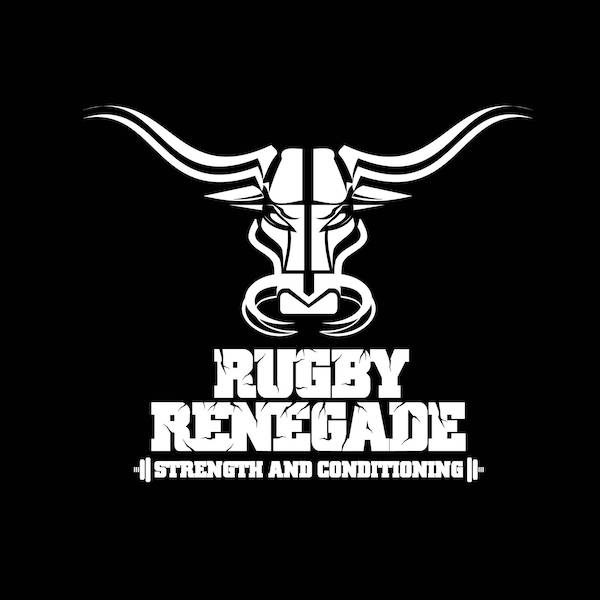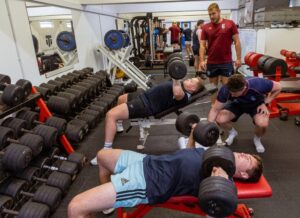Shoulder injuries account for up to 20% of injuries in rugby union, with a recurrence rate as high as 75%… As players are becoming bigger, stronger, faster and fitter there needs to be an emphasis on pre-hab and injury prevention to prepare the shoulder for the rigours of the game.
Unlike any other non-contact field based sports, contact sports like rugby (both codes) places an incredible amount of force and trauma on the shoulders of the athletes that play them. Typical accelerations on the field can be 2.5m/s/s, players can easily weigh above the 110kg mark, and running speeds often reach above 30kph. Running at this speed, with that momentum to stopping in a fraction of a second leads to forces of above 270N! And the shoulder deals with a large proportion of these forces!
To reduce injury risk the key focus areas are:
1. Work on developing sufficient thoracic rotation and extension. Without a mobile thoracic spine the shoulder can become vulnerable to poor biomechanics and overloading.
2. Get the rotator cuff firing and develop strong reactive musculature across the shoulder joint.
3. The final point was to keep these exercises in your program. The cuff gets fatigued and inhibited by all the work it has to do tackling, scrummaging and smashing rucks. By keeping these drills as a regular feature in your program, you will keep the cuff firing and reduce your risk of injury. ultimately developing Rugby Proof Shoulders!
The shoulder can be seen as quite a complex region of the body. Developing strength and range of movement in the shoulder complex and having the ability to control both qualities will create a robust shoulder to use on the rugby field.
When we talk about the shoulder we are talking about the humerus (upper arm) clavicle (collar bone), scapula (shoulder blade), and the thorax (rib cage) and all the soft tissue that connects them. Due to the interaction of all these bones and structures the shoulder complex actually involves 4 joints; the glenohumeral joint, acromioclavicular joint, sternoclavicular, and scapulothoracic joint.
The shoulder joint is a ball and socket joint, just like your hip, but the shoulder has sacrificed stability for range of movement. So unlike the hip the shoulder socket is far shallower which is why on occasion the stabilisers we do have, fail. As a result we suffer shoulder subluxations and dislocations far more frequently than we do for the hip. The primary stabilisers of the joint are the ligaments and the shape of the joints just like in other joints of the body but the muscular secondary and tertiary stabilisers of the shoulder are especially important due to the joint’s lack of bony stability.
Primary Stabilisers
The primary stabilisers of the glenohumeral joint can be summarized as the architecture of the glenohumeral joint where you get the convex surface of the humerus held in place by the bowl like shape of the concave glenoid cavity of the scapula. This joint is further supported by the glenohumeral ligaments. Within this ligament complex you have 3 major ligaments;
Superior Glenohumeral Ligament
Middle Glenohumeral Ligament
Inferior Glenohumeral Ligament
Secondary Stabilisers
Within the shoulder there are some key players to be aware of that will help stabilise and secure the shoulder in its socket. The shoulder is heavily reliant on muscles to stabilise the joint due to the reduced stability it has thanks to the anatomy that allows it to have such a vast degree of movement. The muscles that cross the shoulder joint all work together to keep the head of the humerus where it should be, in it’s socket. The relative contribution of each muscle across the shoulder will vary depending on the position of the arm relative to the body and the load that it has to control.
The rotator cuff is a key stabiliser of the shoulder; a group of four local stabilizer muscles that sit around the glenohumeral joint. These muscles are responsible for securing the humerus in the joint of the shoulder and are the deepest layer of muscles acting on the shoulder. It is comprised of four muscles, the supraspinatus, infraspinatus and teres minor muscles that all sit on the posterior (back) aspect of the joint, and the subscapularis that sits at the front of the joint between the scapula and the torso.
Tertiary Stabilisers
There are also a number of other key muscles and structures that help the mechanics of the shoulder and add tertiary stability. A few of these will be familiar to you. The Levator Scapulae, the upper, middle and lower trapezius, the rhomboids on the posterior (back) aspect of the body that influence the scapula and its movements. Serratus anterior that crosses from the back of the scapula to the flank of the body, Latissimus Dorsi, the deltoids, pectoralis major and pectoralis minor muscles that move and stabilise the humerus and scapula. Moving down into the upper arm; biceps, triceps and corracobrachialis. The tertiary stabilizers are responcible for driving movement but they all contribute to stability. Especialy high threshold stability that is needed on the rugby field
An important component of your rugby proof shoulder program needs to be overall fitness too. A lot of shoulder injries accur when players get themselves in vulnerable positions during contact situations. If your general fitness does not allow you to set yourself in a strong position for contact you’re more likely tohave to throw out an arm or launch across to make a contact and make a tackle. This increases the risk of injury when compared to a tackle made when your hips and lower body are closer in with arms closer to the trunk.
Here are some example drills that we use as part of our injury prevention program in the members area. If you have any issues with your shoulder make sure that you get reviewed by a professional before trying any of the exercises on our site.
You can also view our full injury prevention playlist for the shoulder on our YouTube channel. Were constantly updating our library so make sure you subscribe and sign up to our email list to stay up to date with all of our content.




